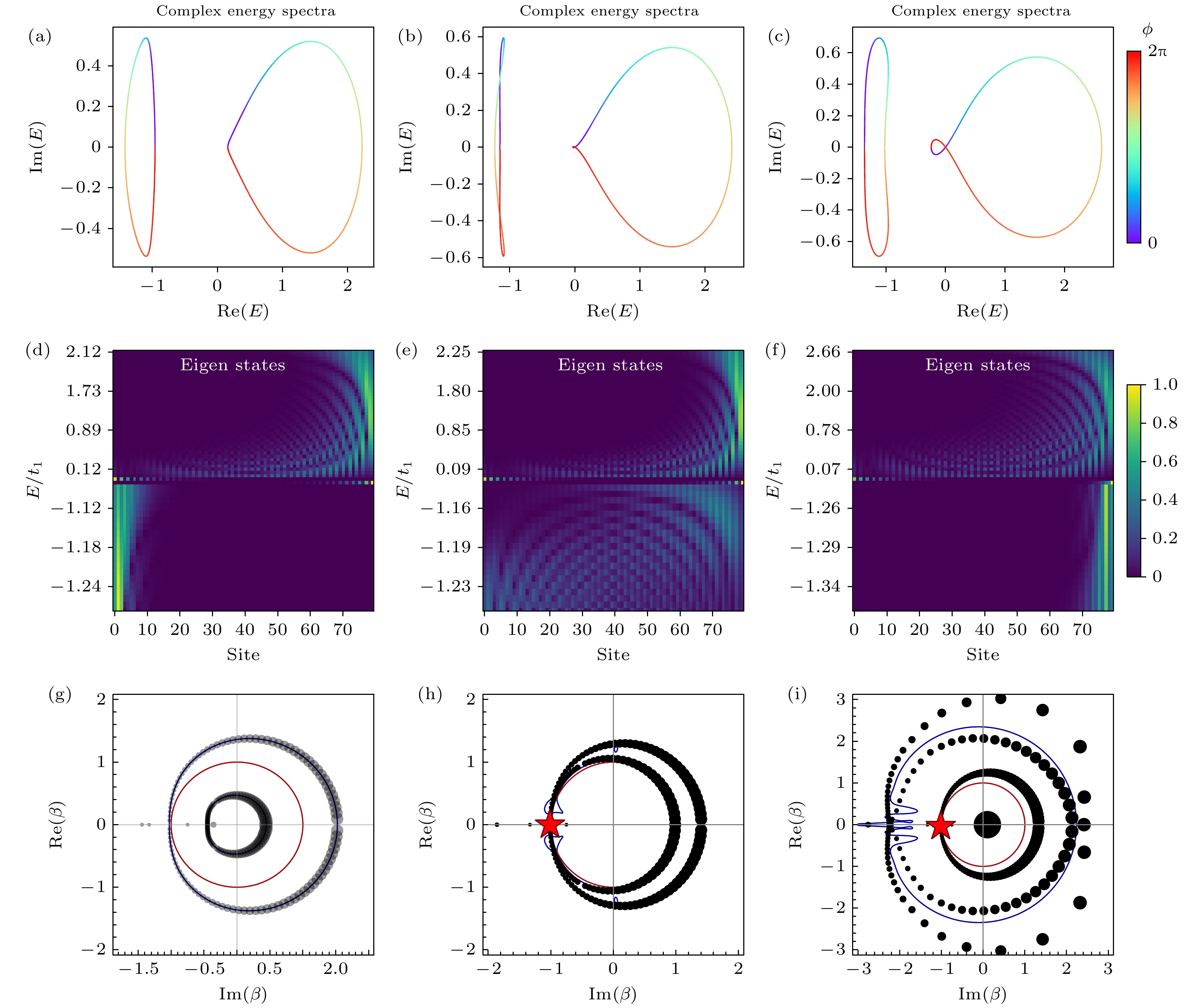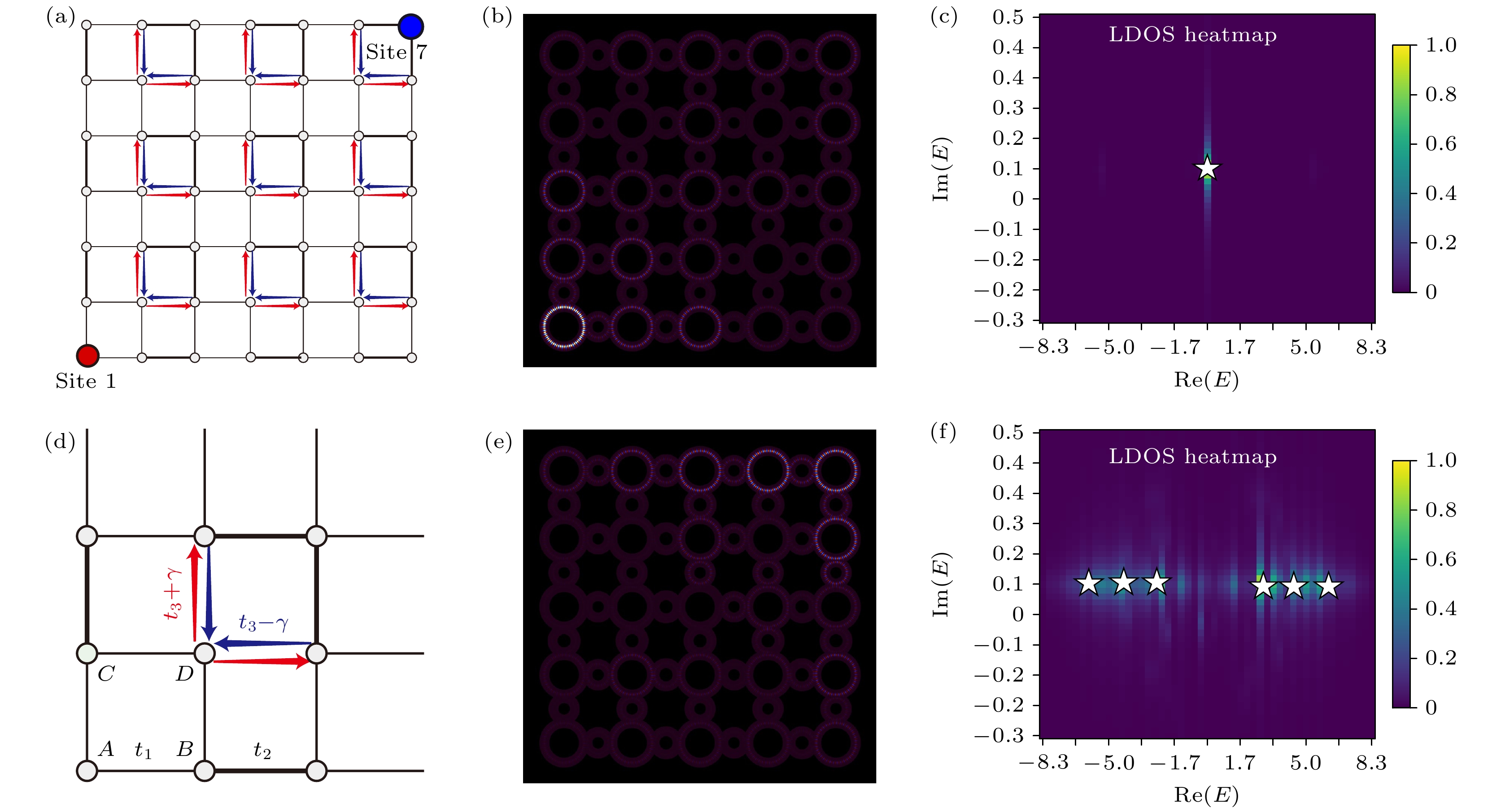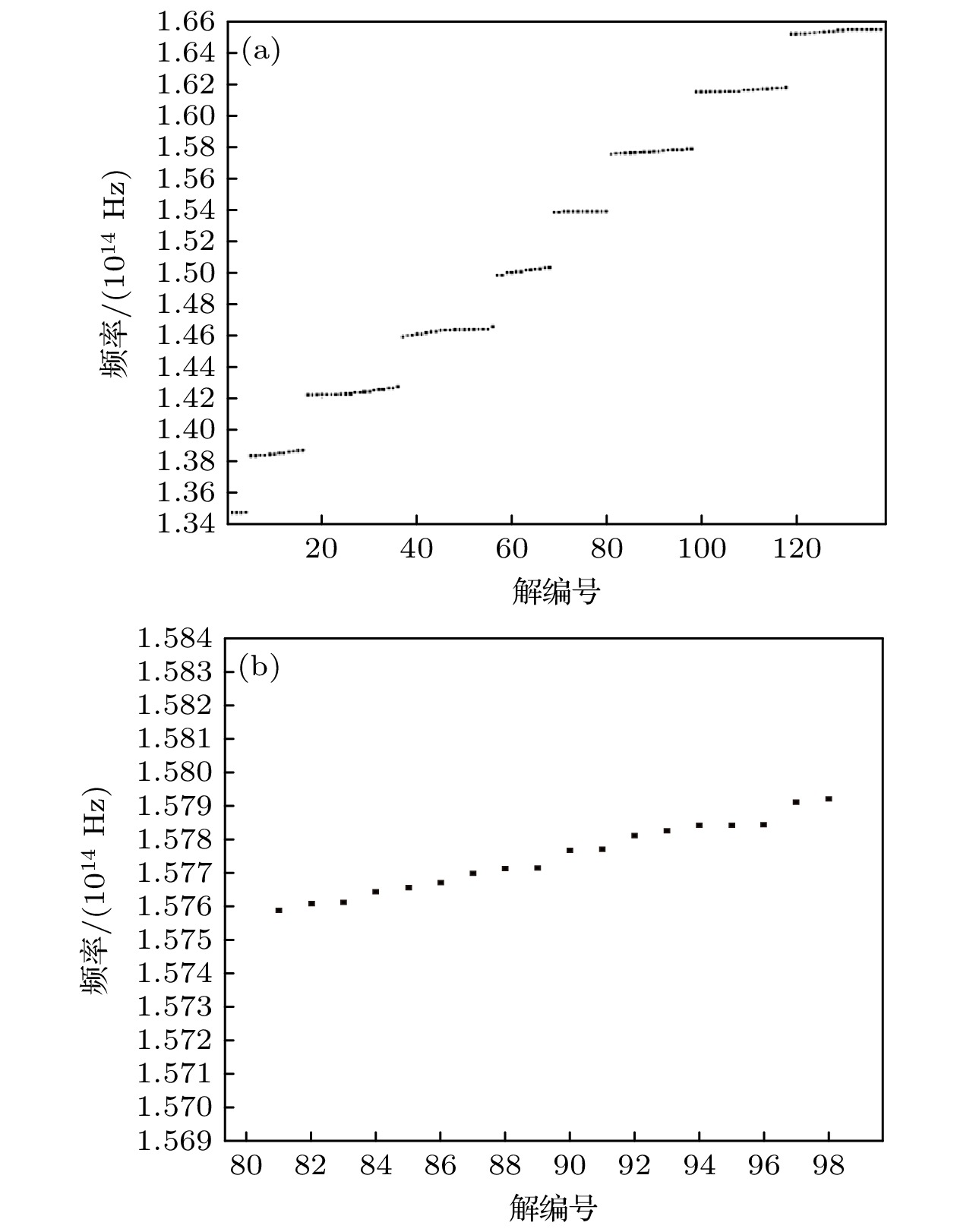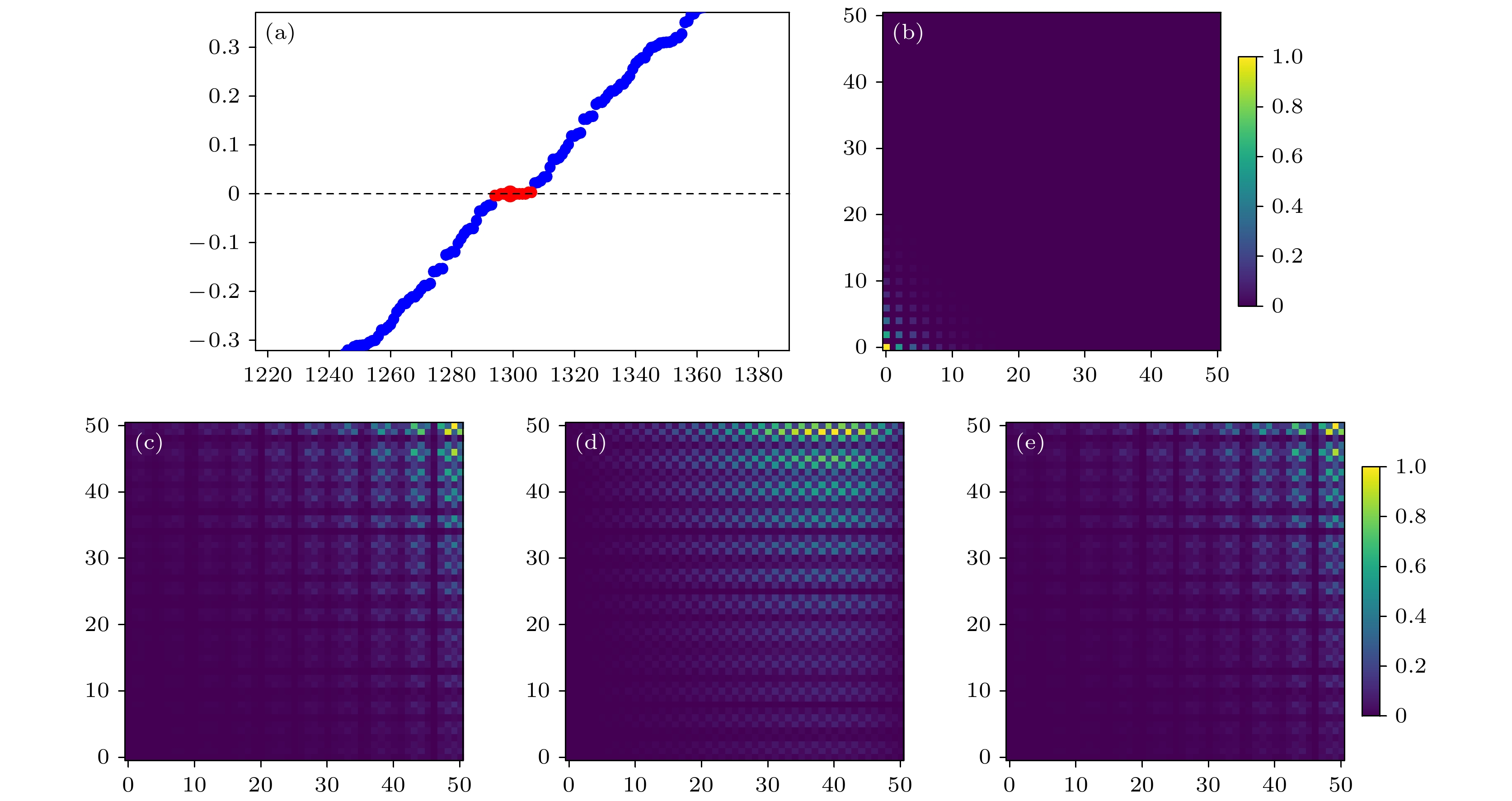-
拓扑边界态因在带隙中的鲁棒性和无损耗的传输特性备受关注, 但在复杂系统中实现其稳定激发仍是一个挑战. 本文提出了一种利用亚对称性保护的边界态与长程非互易耦合系数, 实现具有拓扑选择性的非厄米趋肤效应 (non-Hermitian skin effect, NHSE) 的方法. 该方法能够选择性地对平庸体态施加非厄米趋肤效应, 同时保持拓扑边界态不受影响, 从而实现拓扑模式与体态模式在空间上的有效分离, 并在能带密集的系统中实现鲁棒的边界态激发. 此外, 本文将该模型扩展到二维体系, 实现了角态与体态模式的有效分离. 通过紧束缚模型进行理论预测, 分析了该模型中非厄米效应对能谱和趋肤性质的调控机制, 并利用有限元仿真在光学耦合环中验证了这一机制的可行性, 研究了非厄米趋肤效应的本征态特性, 并实现了拓扑态的鲁棒激发. 该机制将非厄米物理与拓扑光子学相结合, 为提升光子系统中信号的稳定性提供了新的思路与方向.Topologically protected waveguides have aroused increasing interest due to their robustness against disorder and defects. In parallel, the advent of non-Hermitian physics with its inherent gain-and-loss mechanisms has introduced new tools for manipulating wave localization and transport. However, most attempts to combine non-Hermitian effects with topological systems uniformly impose the non-Hermitian skin effect (NHSE) on all modes, without selectivity targeting topological states. In this work, we propose a scheme thatachieves topologically selective NHSE by combining sub-symmetry-protected boundary modes with long-range non-reciprocal couplings. In an improved Su–Schrieffer–Heeger (SSH) chain, we analytically demonstrate that robust zero-energy edge modes can be preserved even in spectra filled with bulk states, while selectively applying the NHSE to the trivial bulk states to achieve the spatial separation between topological state and bulk state. By adjusting the long-range couplings a non-Hermitian phase transition can be observed in the complex energy spectrum: it transitions from a closed loop (circle) to an open arc, and ultimately to a reversely coiled loop. These transitions correspond respectively to a leftward NHSE, the disappearance of the NHSE, and a rightward NHSE. According to the calculations of the generalized Brillouin zone (GBZ), we confirm this transition by observing the GBZ passing through the unit circle, indicating a change in the direction of NHSE.We further extend our model to a two-dimensional higher-order SSH lattice, where selective non-Hermitian modulation enables clear spatial separation between topological corner states and bulk modes. To quantify this, we compute the local density of states (LDOS) in the complex energy plane for site 0 (a topologically localized corner) and site 288 (a region exhibiting NHSE). The comparison of LDOS between the two sites reveals that the topological states are primarily localized at site 0, while the bulk states affected by NHSE accumulate at site 288.To validate the theoretical predictions, we perform finite-element simulations of optical resonator arrays by using whispering-gallery modes. By adjusting the coupling distances and incorporating gain/loss through refractive index engineering, we replicate the modified SSH model and confirm the selective localization of topological and bulk modes.Our results provide a robust method for selectively exciting and spatially controlling the topological states in non-Hermitian systems, and also lay a foundation for future low-crosstalk high-stability topological photonic devices.
[1] Su W P, Schrieffer J R, Heeger A J 1979 Phys. Rev. Lett. 42 1698
 Google Scholar
Google Scholar
[2] Wang Z, Chong Y, Joannopoulos J D, Soljačić M 2009 Nature 461 772
 Google Scholar
Google Scholar
[3] Hafezi M, Demler E A, Lukin M D, Taylor J M 2011 Nat. Phys. 7 907
 Google Scholar
Google Scholar
[4] Fang K, Yu Z, Fan S 2012 Nat. Photonics 6 782
 Google Scholar
Google Scholar
[5] Hafezi M, Mittal S, Fan J, Migdall A, Taylor J M 2013 Nat. Photonics 7 1001
 Google Scholar
Google Scholar
[6] Khanikaev A B, Hossein Mousavi S, Tse W K, Kargarian M, MacDonald A H, Shvets G 2013 Nat. Mater. 12 233
 Google Scholar
Google Scholar
[7] Wu L H, Hu X 2015 Phys. Rev. Lett. 114 223901
 Google Scholar
Google Scholar
[8] Ma T, Shvets G 2016 New J. Phys. 18 025012
 Google Scholar
Google Scholar
[9] 王子尧, 陈福家, 郗翔, 高振, 杨怡豪 2024 73 064201
 Google Scholar
Google Scholar
Wang Z Y, Chen F J, Xi X, Gao Z, Yang Y H 2024 Acta Phys. Sin. 73 064201
 Google Scholar
Google Scholar
[10] 王洪飞, 解碧野, 詹鹏, 卢明辉, 陈延峰 2019 68 224206
 Google Scholar
Google Scholar
Wang H F, Xie B Y, Zhan P, Lu M H, Chen Y F 2019 Acta Phys. Sin. 68 224206
 Google Scholar
Google Scholar
[11] 孙晓晨, 何程, 卢明辉, 陈延峰 2017 66 224203
 Google Scholar
Google Scholar
Sun X C, He C, Lu M H, Chen Y F 2017 Acta Phys. Sin. 66 224203
 Google Scholar
Google Scholar
[12] Xie B, Wang H X, Zhang X, Zhan P, Jiang J H, Lu M, Chen Y 2021 Nat. Rev. Phys. 3 520
 Google Scholar
Google Scholar
[13] Benalcazar W A, Noh J, Wang M, Huang S, Chen K P, Rechtsman M C 2022 Phys. Rev. B 105 195129
 Google Scholar
Google Scholar
[14] Wang Q, Xue H, Zhang B, Chong Y 2020 Phys. Rev. Lett. 124 243602
 Google Scholar
Google Scholar
[15] 胡军容, 孔鹏, 毕仁贵, 邓科, 赵鹤平 2022 71 054301
 Google Scholar
Google Scholar
Hu J R, Kong P, Bi R G, Deng K, Zhao H P 2022 Acta Phys. Sin. 71 054301
 Google Scholar
Google Scholar
[16] 严忠波 2019 68 226101
 Google Scholar
Google Scholar
Yan Z B 2019 Acta Phys. Sin. 68 226101
 Google Scholar
Google Scholar
[17] Wang Z, Wang X, Hu Z, et al. 2023 Nat. Phys. 19 992
 Google Scholar
Google Scholar
[18] Bender C M, Boettcher S 1998 Phys. Rev. Lett. 80 5243
 Google Scholar
Google Scholar
[19] Bender C M 2007 Rep. Prog. Phys. 70 947
 Google Scholar
Google Scholar
[20] Bender C, Boettcher S, Meisinger P 1999 J. Math. Phys. 40 2201
 Google Scholar
Google Scholar
[21] Yao S, Wang Z 2018 Phys. Rev. Lett. 121 086803
 Google Scholar
Google Scholar
[22] Lee T E 2016 Phys. Rev. Lett. 116 133903
 Google Scholar
Google Scholar
[23] Okuma N, Kawabata K, Shiozaki K, Sato M 2020 Phys. Rev. Lett. 124 086801
 Google Scholar
Google Scholar
[24] Song W, Sun W, Chen C, Song Q, Xiao S, Zhu S, Li T 2019 Phys. Rev. Lett. 123 165701
 Google Scholar
Google Scholar
[25] Li Y, Liang C, Wang C, Lu C, Liu Y C 2022 Phys. Rev. Lett. 128 223903
 Google Scholar
Google Scholar
[26] Wang W, Wang X, Ma G 2022 Nature 608 50
 Google Scholar
Google Scholar
[27] Zhu W, Gong J 2022 Phys. Rev. B 106 035425
 Google Scholar
Google Scholar
[28] Liu G G, Mandal S, Zhou P, Xi X, Banerjee R, Hu Y H, Wei M, Wang M, Wang Q, Gao Z, Chen H, Yang Y, Chong Y, Zhang B 2024 Phys. Rev. Lett. 132 113802
 Google Scholar
Google Scholar
[29] Song W, Lin Z, Ji J, Sun J, Chen C, Wu S, Huang C, Yuan L, Zhu S, Li T 2024 Phys. Rev. Lett. 132 143801
 Google Scholar
Google Scholar
[30] Chen J, Shi A, Peng Y, Peng P, Liu J 2024 Chin. Phys. Lett. 41 037103
 Google Scholar
Google Scholar
[31] Martinez Alvarez V M, Barrios Vargas J E, Foa Torres L E F 2018 Phys. Rev. B 97 121401
 Google Scholar
Google Scholar
[32] Pan M, Zhao H, Miao P, Longhi S, Feng L 2018 Nat. Commun. 9 1308
 Google Scholar
Google Scholar
[33] Huang Q K L, Liu Y K, Cao P C, Zhu X F, Li Y 2023 Chin. Phys. Lett. 40 106601
 Google Scholar
Google Scholar
[34] Leykam D, Bliokh K Y, Huang C, Chong Y, Nori F 2017 Phys. Rev. Lett. 118 040401
 Google Scholar
Google Scholar
[35] Liu X, Lin Z, Song W, Sun J, Huang C, Wu S, Xiao X, Xin H, Zhu S, Li T 2024 Phys. Rev. Lett. 132 016601
 Google Scholar
Google Scholar
[36] Jackiw R, Rebbi C 1976 Phys. Rev. D 13 3398
 Google Scholar
Google Scholar
[37] Qi X L, Wu Y S, Zhang S C 2006 Phys. Rev. B 74 045125
 Google Scholar
Google Scholar
[38] Zhang K, Yang Z, Fang C 2020 Phys. Rev. Lett. 125 126402
 Google Scholar
Google Scholar
[39] Yang Z, Zhang K, Fang C, Hu J 2020 Phys. Rev. Lett. 125 226402
 Google Scholar
Google Scholar
[40] Wang Z, Wang X, Li A, Zhang K, Ji Y, Zhong M 2023 Chin. Phys. B 32 064207
 Google Scholar
Google Scholar
[41] 陈云天, 王经纬, 陈伟锦, 徐竞 2020 69 154206
 Google Scholar
Google Scholar
Chen Y T, Wang J W, Chen W J, Xu J 2020 Acta Phys. Sin. 69 154206
 Google Scholar
Google Scholar
[42] Ozawa T, Price H M, Amo A, Goldman N, Hafezi M, Lu L, Rechtsman M C, Schuster D, Simon J, Zilberberg O, Carusotto I 2019 Rev. Mod. Phys. 91 015006
 Google Scholar
Google Scholar
[43] Yan Q C, Ma R, Hu X Y, Gong Q H 2023 Chin. Phys. B 33 010301
 Google Scholar
Google Scholar
[44] Xu Y X, Tang W J, Jiang L W, Wu D X, Wang H, Xu B C, Chen L 2024 Chin. Phys. B 33 060306
 Google Scholar
Google Scholar
[45] Wu D, Chen J, Su W, Wang R, Wang B, Xing D Y 2023 Commun. Phys. 6 1
 Google Scholar
Google Scholar
[46] Xu X W, Li Y Z, Liu Z F, Chen A X 2020 Phys. Rev. A 101 063839
 Google Scholar
Google Scholar
-
图 1 (a) 系统的紧束缚耦合示意图, 红色/黄色为A/B位点, 耦合系数为$ t_1, t_2, t_3, \gamma $, 箭头表示具有方向的耦合系数; (b) 系统的实能量分布随$ t_1 $的变化图; (c) 系统的复能量分布, 颜色的变化代表Bloch动量相位(ϕ)的变化; (d) 具有选择性非厄米趋肤效应的模式图, 横坐标为位点, 纵坐标为实能量, 白字标示了耦合参数大小; (e) 无拓扑模式非厄米趋肤效应的模式图, 横坐标为位点, 纵坐标为实能量, 白字标示了耦合参数大小; (f) 具有反方向非厄米趋肤效应的模式图, 横坐标为位点, 纵坐标为实能量, 白字表示了耦合参数大小
Fig. 1. (a) Schematic diagram of the system's tight-binding couplings. Red/yellow dots represent A/B sites, and the coupling coefficients are $ t_1 $, $ t_2 $, $ t_3 $, and γ. Arrows indicate direction-dependent coupling. (b) Plot of the system’s real energy spectrum as $ t_1 $ changes from $ -3 $ to $ 3 $. (c) System’s complex energy spectrum. The color gradient indicates the variation of the Bloch momentum phase (ϕ). (d) Mode distribution exhibiting topological selective non-Hermitian skin effect, white text denotes coupling coefficients. The horizontal axis represents site index, and the vertical axis represents real energy. (e) Mode distribution under non-Hermitian skin effect without topological modes. The horizontal axis represents site index, and the vertical axis represents real energy, white text denotes coupling coefficients. (f) Mode distribution exhibiting reverse non-Hermitian skin effect. The horizontal axis represents site index, and the vertical axis represents real energy, white text denotes coupling coefficients.
图 2 (a), (d), (g) $ t_3=0.4 $时的能带, 本征态分布和GBZ, (a)横坐标/纵坐标分别为实/虚能量, 颜色图标代表Bloch动量的相位ϕ, (d)横坐标/纵坐标为位点/能量, 颜色图标代表模式振幅, (g)横坐标/纵坐标为虚/实β, 灰色小球代表有限模型$ (n=100) $计算出的GBZ, 红星处$ \beta =1 $; (b), (e), (h) $ t_3=0.59 $时的能带, 本征态分布和GBZ; (c), (f), (i) $ t_3=0.8 $时的能带, 本征态分布和GBZ
Fig. 2. (a), (d), (g) Energy bands, eigenstate and GBZ at $ t_3 = 0.4 $. In (a), the horizontal(vertical) axes is real (imaginary) parts of eigen energy, color bar indicates the phase of the Bloch momentum. In (d), the horizontal axis is the site index, the vertical axis is the energy, and the color bar represents the mode amplitude. In (g), the horizontal (vertical) axes is real (imaginary) parts of β, gray dots means GBZ calculated from finite model ($ n=100 $), the red star means where $ \beta=1 $. (b), (e), (h) Energy bands, eigenstate distribution and GBZ at $ t_3 = 0.59 $. (c), (f), (i) Energy bands, eigenstate distribution and GBZ at $ t_3 = 0.8 $.
图 3 (a) 耦合环示意图; (b) 有限元仿真的周期行边界复能带, x轴为实频率, y轴为复频率; (c) 有限元仿真的开放边界能带$ (n=10) $, x轴为解数, y轴为实频率, 红色五角星代表拓扑态; (d) 有限元仿真的向左的NHSE; (e) 有限元仿真的向右的NHSE; (f) 有限元仿真中的拓扑模式; (g) 在特定位点上激发的拓扑模式
Fig. 3. (a) Schematic diagram of the coupling rings; (b) complex energy band of finite element simulation under periodic boundary condition; (c) real energy band of finite element simulation under open boundary condition$ (n=10) $, the red star denotes topological states; (d) leftward non-Hermitian skin effect (NHSE) from finite element simulation; (e) rightward non-Hermitian skin effect (NHSE) from finite element simulation; (f) topological mode in the finite element simulation; (g) excited topological mode.
图 4 (a) 2维高阶SSH模型示意图; (b) 非互易耦合环中的二维高阶拓扑态; (c) 位点0处的复平面LDOS; (d) 二维模型的放大示意图; (e) $ B, C, D $三个位点非互易耦合导致的体态非厄米效应; (f) 位点288处的复平面LDOS
Fig. 4. (a) schematic diagram of the 2D higher-order SSH model. (b) 2D higher-order topological state in the presence of non-reciprocal coupling rings. (c) complex plane LDOS at finite slab site 0. (d) enlarged unit cell schematic of the 2D model. (e) non-Hermitian skin effect on bulk states induced by non-reciprocal coupling among sites B, C, and D. (f) complex plane LDOS at site 288.
图 A2 (a) 2D选择性非互易趋肤效应SSH模型的本征能带, 红色表示零能模式; (b) 2D选择性模式中不受到影响的零能模式; (c) 2D选择性非互易趋肤效应SSH模型的代表本征态之一; (d) 2D选择性非互易趋肤效应SSH模型的代表本征态之二; (e) 2D选择性非互易趋肤效应SSH模型的代表本征态之三
Fig. A2. (a) Eigenenergy band of the 2D selective non-reciprocal skin effect SSH model, red denote zero energy mode; (b) 2D topological mode not affected by the selective skin effect; (c) representative eigenstate 1 of the 2D selective non-reciprocal skin; (d) representative eigenstate 2 of the 2D selective non-reciprocal skin; (e) representative eigenstate 3 of the 2D selective non-reciprocal skin.
-
[1] Su W P, Schrieffer J R, Heeger A J 1979 Phys. Rev. Lett. 42 1698
 Google Scholar
Google Scholar
[2] Wang Z, Chong Y, Joannopoulos J D, Soljačić M 2009 Nature 461 772
 Google Scholar
Google Scholar
[3] Hafezi M, Demler E A, Lukin M D, Taylor J M 2011 Nat. Phys. 7 907
 Google Scholar
Google Scholar
[4] Fang K, Yu Z, Fan S 2012 Nat. Photonics 6 782
 Google Scholar
Google Scholar
[5] Hafezi M, Mittal S, Fan J, Migdall A, Taylor J M 2013 Nat. Photonics 7 1001
 Google Scholar
Google Scholar
[6] Khanikaev A B, Hossein Mousavi S, Tse W K, Kargarian M, MacDonald A H, Shvets G 2013 Nat. Mater. 12 233
 Google Scholar
Google Scholar
[7] Wu L H, Hu X 2015 Phys. Rev. Lett. 114 223901
 Google Scholar
Google Scholar
[8] Ma T, Shvets G 2016 New J. Phys. 18 025012
 Google Scholar
Google Scholar
[9] 王子尧, 陈福家, 郗翔, 高振, 杨怡豪 2024 73 064201
 Google Scholar
Google Scholar
Wang Z Y, Chen F J, Xi X, Gao Z, Yang Y H 2024 Acta Phys. Sin. 73 064201
 Google Scholar
Google Scholar
[10] 王洪飞, 解碧野, 詹鹏, 卢明辉, 陈延峰 2019 68 224206
 Google Scholar
Google Scholar
Wang H F, Xie B Y, Zhan P, Lu M H, Chen Y F 2019 Acta Phys. Sin. 68 224206
 Google Scholar
Google Scholar
[11] 孙晓晨, 何程, 卢明辉, 陈延峰 2017 66 224203
 Google Scholar
Google Scholar
Sun X C, He C, Lu M H, Chen Y F 2017 Acta Phys. Sin. 66 224203
 Google Scholar
Google Scholar
[12] Xie B, Wang H X, Zhang X, Zhan P, Jiang J H, Lu M, Chen Y 2021 Nat. Rev. Phys. 3 520
 Google Scholar
Google Scholar
[13] Benalcazar W A, Noh J, Wang M, Huang S, Chen K P, Rechtsman M C 2022 Phys. Rev. B 105 195129
 Google Scholar
Google Scholar
[14] Wang Q, Xue H, Zhang B, Chong Y 2020 Phys. Rev. Lett. 124 243602
 Google Scholar
Google Scholar
[15] 胡军容, 孔鹏, 毕仁贵, 邓科, 赵鹤平 2022 71 054301
 Google Scholar
Google Scholar
Hu J R, Kong P, Bi R G, Deng K, Zhao H P 2022 Acta Phys. Sin. 71 054301
 Google Scholar
Google Scholar
[16] 严忠波 2019 68 226101
 Google Scholar
Google Scholar
Yan Z B 2019 Acta Phys. Sin. 68 226101
 Google Scholar
Google Scholar
[17] Wang Z, Wang X, Hu Z, et al. 2023 Nat. Phys. 19 992
 Google Scholar
Google Scholar
[18] Bender C M, Boettcher S 1998 Phys. Rev. Lett. 80 5243
 Google Scholar
Google Scholar
[19] Bender C M 2007 Rep. Prog. Phys. 70 947
 Google Scholar
Google Scholar
[20] Bender C, Boettcher S, Meisinger P 1999 J. Math. Phys. 40 2201
 Google Scholar
Google Scholar
[21] Yao S, Wang Z 2018 Phys. Rev. Lett. 121 086803
 Google Scholar
Google Scholar
[22] Lee T E 2016 Phys. Rev. Lett. 116 133903
 Google Scholar
Google Scholar
[23] Okuma N, Kawabata K, Shiozaki K, Sato M 2020 Phys. Rev. Lett. 124 086801
 Google Scholar
Google Scholar
[24] Song W, Sun W, Chen C, Song Q, Xiao S, Zhu S, Li T 2019 Phys. Rev. Lett. 123 165701
 Google Scholar
Google Scholar
[25] Li Y, Liang C, Wang C, Lu C, Liu Y C 2022 Phys. Rev. Lett. 128 223903
 Google Scholar
Google Scholar
[26] Wang W, Wang X, Ma G 2022 Nature 608 50
 Google Scholar
Google Scholar
[27] Zhu W, Gong J 2022 Phys. Rev. B 106 035425
 Google Scholar
Google Scholar
[28] Liu G G, Mandal S, Zhou P, Xi X, Banerjee R, Hu Y H, Wei M, Wang M, Wang Q, Gao Z, Chen H, Yang Y, Chong Y, Zhang B 2024 Phys. Rev. Lett. 132 113802
 Google Scholar
Google Scholar
[29] Song W, Lin Z, Ji J, Sun J, Chen C, Wu S, Huang C, Yuan L, Zhu S, Li T 2024 Phys. Rev. Lett. 132 143801
 Google Scholar
Google Scholar
[30] Chen J, Shi A, Peng Y, Peng P, Liu J 2024 Chin. Phys. Lett. 41 037103
 Google Scholar
Google Scholar
[31] Martinez Alvarez V M, Barrios Vargas J E, Foa Torres L E F 2018 Phys. Rev. B 97 121401
 Google Scholar
Google Scholar
[32] Pan M, Zhao H, Miao P, Longhi S, Feng L 2018 Nat. Commun. 9 1308
 Google Scholar
Google Scholar
[33] Huang Q K L, Liu Y K, Cao P C, Zhu X F, Li Y 2023 Chin. Phys. Lett. 40 106601
 Google Scholar
Google Scholar
[34] Leykam D, Bliokh K Y, Huang C, Chong Y, Nori F 2017 Phys. Rev. Lett. 118 040401
 Google Scholar
Google Scholar
[35] Liu X, Lin Z, Song W, Sun J, Huang C, Wu S, Xiao X, Xin H, Zhu S, Li T 2024 Phys. Rev. Lett. 132 016601
 Google Scholar
Google Scholar
[36] Jackiw R, Rebbi C 1976 Phys. Rev. D 13 3398
 Google Scholar
Google Scholar
[37] Qi X L, Wu Y S, Zhang S C 2006 Phys. Rev. B 74 045125
 Google Scholar
Google Scholar
[38] Zhang K, Yang Z, Fang C 2020 Phys. Rev. Lett. 125 126402
 Google Scholar
Google Scholar
[39] Yang Z, Zhang K, Fang C, Hu J 2020 Phys. Rev. Lett. 125 226402
 Google Scholar
Google Scholar
[40] Wang Z, Wang X, Li A, Zhang K, Ji Y, Zhong M 2023 Chin. Phys. B 32 064207
 Google Scholar
Google Scholar
[41] 陈云天, 王经纬, 陈伟锦, 徐竞 2020 69 154206
 Google Scholar
Google Scholar
Chen Y T, Wang J W, Chen W J, Xu J 2020 Acta Phys. Sin. 69 154206
 Google Scholar
Google Scholar
[42] Ozawa T, Price H M, Amo A, Goldman N, Hafezi M, Lu L, Rechtsman M C, Schuster D, Simon J, Zilberberg O, Carusotto I 2019 Rev. Mod. Phys. 91 015006
 Google Scholar
Google Scholar
[43] Yan Q C, Ma R, Hu X Y, Gong Q H 2023 Chin. Phys. B 33 010301
 Google Scholar
Google Scholar
[44] Xu Y X, Tang W J, Jiang L W, Wu D X, Wang H, Xu B C, Chen L 2024 Chin. Phys. B 33 060306
 Google Scholar
Google Scholar
[45] Wu D, Chen J, Su W, Wang R, Wang B, Xing D Y 2023 Commun. Phys. 6 1
 Google Scholar
Google Scholar
[46] Xu X W, Li Y Z, Liu Z F, Chen A X 2020 Phys. Rev. A 101 063839
 Google Scholar
Google Scholar
计量
- 文章访问数: 1183
- PDF下载量: 126
- 被引次数: 0














 下载:
下载:






